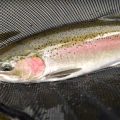Snoqualmie River Restoration Project Begins
A project to restore salmon, steelhead, and other wildlife habitats on the Snoqualmie River has recently begun, in a partnership of Wild Fish Conservancy, Washington Department of Fish and Wildlife and Ducks Unlimited.
Read more in the press release below.
Restoration Project on Snoqualmie to Restore Natural Processes and Habitats for Salmon and Other Threatened Species
For Immediate Release:
Wild Fish Conservancy recently began construction on its Stillwater Floodplain Restoration Project, located within the 456-acre Stillwater Wildlife Unit on the Snoqualmie River between Carnation and Duvall, WA. This $850,000 project, a culmination of seven years of planning and preparation, is restoring salmon, steelhead, and other wildlife habitats along this reach of the Snoqualmie River. This restoration project will restore natural river processes that were damaged years ago by river revetment construction. Wild Fish Conservancy, in partnership with WDFW and Ducks Unlimited, is removing 2,100 feet of revetment along the eastern shore of the Snoqualmie in this reach, with roughly 100-140 truckloads of material removed daily. This project is an important example of how private landowners, public agencies, and non-profit groups can work collaboratively for the betterment of wild fish, with an added bonus of creating local jobs. The construction phase of this project will be completed within the next two weeks.
The Snoqualmie River is regionally important for Chinook recovery, home to one of the most important of twenty-two individual populations that makes up the Puget Sound Chinook “Evolutionarily Significant Unit” or ESU. The ESU – meaning Puget Sound Chinook salmon – was listed as a “threatened” species under the federal Endangered Species Act in 1999. The river also provides habitat for important populations of listed species, namely bull trout (listed as a threatened species in 2000), and Puget Sound steelhead (listed as a threatened species in May 2007), as well as coho, chum, sockeye, and pink salmon, and many other native fish and wildlife species.
The Snohomish Basin Salmon Conservation Plan has designated the river reach that the Stillwater Unit lies within as the highest priority in the sequence of Snoqualmie River reaches targeted for habitat protection and restoration initiatives. Micah Wait, Conservation Director at Wild Fish Conservancy said “the Stillwater reach is extremely important to salmon recovery in the Snoqualmie. It’s located on the outside shoreline of Chinook Bend, one of the most important Chinook spawning areas in the Snoqualmie Basin.” The site is downstream of all the major Chinook spawning sites in the Snoqualmie River and will provide critical rearing and spawning habitat.
WILD FISH CONSERVANCY
PO Box 402 Duvall, WA 98019 · Tel 425-788-1167 · Fax 425-788-9634 · [email protected]
Contact:
Micah Wait – Wild Fish Conservancy ([email protected], 206-953-9305)
Wild Fish Conservancy is a non-profit organization dedicated to the recovery and conservation of the Northwest region’s wild-fish ecosystems, with over 2,500 members. Wild Fish Conservancy’s staff of over 20 professional scientists, advocates, and educators works to promote technically and socially responsible habitat, hatchery, and harvest management to better sustain the region’s wild fish heritage. For more information, visit us at wildfishconservancy.org or follow us on Facebook at facebook.com/wildfishconservancy.
Help for Dean River Salmon and Steelhead
Western Native Trout to Benefit from National Fish Habitat Partnership Federal Funding











